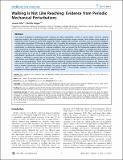| dc.contributor.author | Ahn, Jooeun | |
| dc.contributor.author | Hogan, Neville | |
| dc.date.accessioned | 2012-04-20T17:25:54Z | |
| dc.date.available | 2012-04-20T17:25:54Z | |
| dc.date.issued | 2012-03 | |
| dc.date.submitted | 2011-01 | |
| dc.identifier.issn | 1932-6203 | |
| dc.identifier.uri | http://hdl.handle.net/1721.1/70088 | |
| dc.description.abstract | The control architecture underlying human reaching has been established, at least in broad outline. However, despite extensive research, the control architecture underlying human locomotion remains unclear. Some studies show evidence of high-level control focused on lower-limb trajectories; others suggest that nonlinear oscillators such as lower-level rhythmic central pattern generators (CPGs) play a significant role. To resolve this ambiguity, we reasoned that if a nonlinear oscillator contributes to locomotor control, human walking should exhibit dynamic entrainment to periodic mechanical perturbation; entrainment is a distinctive behavior of nonlinear oscillators. Here we present the first behavioral evidence that nonlinear neuro-mechanical oscillators contribute to the production of human walking, albeit weakly. As unimpaired human subjects walked at constant speed, we applied periodic torque pulses to the ankle at periods different from their preferred cadence. The gait period of 18 out of 19 subjects entrained to this mechanical perturbation, converging to match that of the perturbation. Significantly, entrainment occurred only if the perturbation period was close to subjects' preferred walking cadence: it exhibited a narrow basin of entrainment. Further, regardless of the phase within the walking cycle at which perturbation was initiated, subjects' gait synchronized or phase-locked with the mechanical perturbation at a phase of gait where it assisted propulsion. These results were affected neither by auditory feedback nor by a distractor task. However, the convergence to phase-locking was slow. These characteristics indicate that nonlinear neuro-mechanical oscillators make at most a modest contribution to human walking. Our results suggest that human locomotor control is not organized as in reaching to meet a predominantly kinematic specification, but is hierarchically organized with a semi-autonomous peripheral oscillator operating under episodic supervisory control. | en_US |
| dc.description.sponsorship | New York State Spinal Cord Injury Center of Research Excellence (contract CO19772) | en_US |
| dc.description.sponsorship | Massachusetts Institute of Technology. Eric P. and Evelyn E. Newman Laboratory for Biomechanics and Human Rehabilitation | en_US |
| dc.description.sponsorship | Samsung Scholarship Foundation | en_US |
| dc.language.iso | en_US | |
| dc.publisher | Public Library of Science | en_US |
| dc.relation.isversionof | http://dx.doi.org/10.1371/journal.pone.0031767 | en_US |
| dc.rights | Creative Commons Attribution | en_US |
| dc.rights.uri | http://creativecommons.org/licenses/by/2.5/ | en_US |
| dc.source | PLoS | en_US |
| dc.title | Walking Is Not Like Reaching: Evidence from Periodic Mechanical Perturbations | en_US |
| dc.type | Article | en_US |
| dc.identifier.citation | Ahn, Jooeun, and Neville Hogan. “Walking Is Not Like Reaching: Evidence from Periodic Mechanical Perturbations.” Ed. Paul L. Gribble. PLoS ONE 7.3 (2012): e31767. Web. 20 Apr. 2012. | en_US |
| dc.contributor.department | Massachusetts Institute of Technology. Department of Brain and Cognitive Sciences | en_US |
| dc.contributor.department | Massachusetts Institute of Technology. Department of Mechanical Engineering | en_US |
| dc.contributor.approver | Hogan, Neville | |
| dc.contributor.mitauthor | Ahn, Jooeun | |
| dc.contributor.mitauthor | Hogan, Neville | |
| dc.relation.journal | PLoS ONE | en_US |
| dc.eprint.version | Final published version | en_US |
| dc.type.uri | http://purl.org/eprint/type/JournalArticle | en_US |
| eprint.status | http://purl.org/eprint/status/PeerReviewed | en_US |
| dspace.orderedauthors | Ahn, Jooeun; Hogan, Neville | en |
| dc.identifier.orcid | https://orcid.org/0000-0001-5366-2145 | |
| mit.license | PUBLISHER_CC | en_US |
| mit.metadata.status | Complete | |
